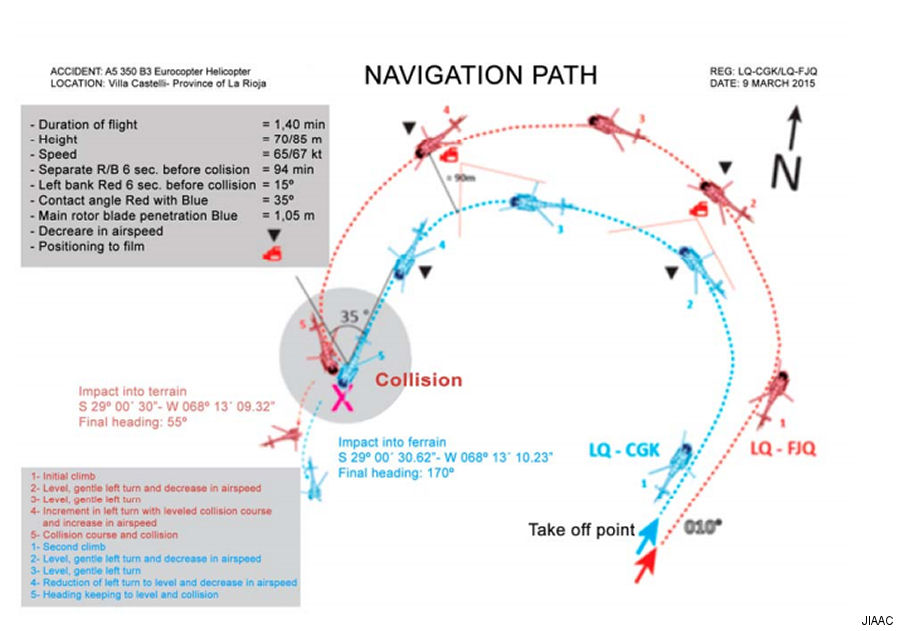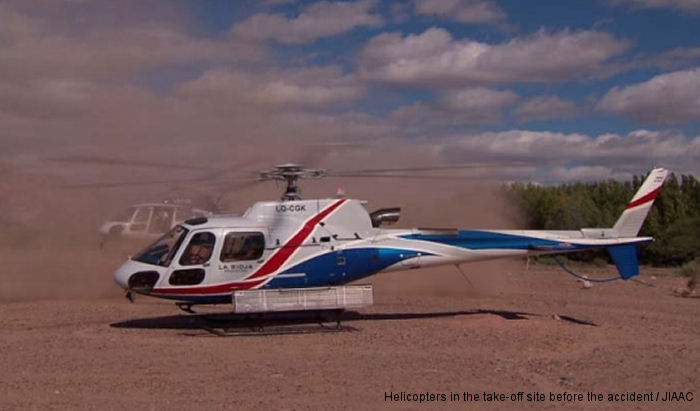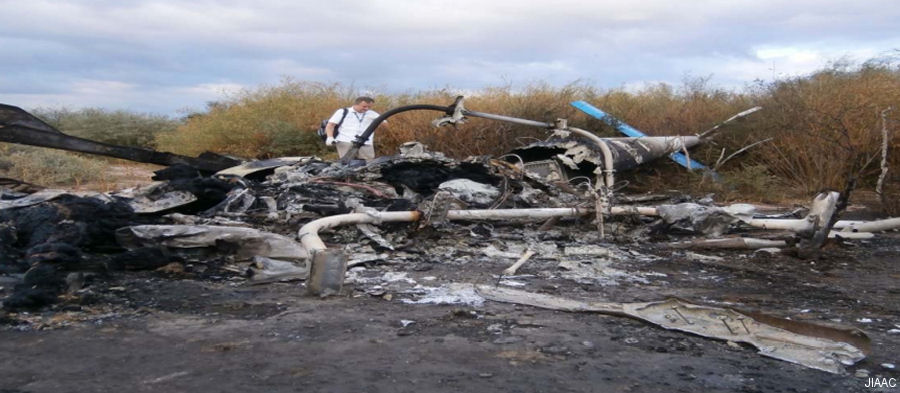
The cooperation of the Aviation Administration of Santiago del Estero had been requested the day before with their helicopter LQ-FJQ to support the activity.
The day of the accident, each aircraft made three flights. Once the flights ended, the LQ-CGK pilot, responsible of the coordination of the task, informed the LQ-FJQ pilot that they would make an additional flight in which there would be passengers on board LQ-CGK and a team of photographer and sound engineer on board LQ-FJQ to make a filming of the flight.
The helicopter pilots and the production Company staff made a briefing about the task to be done: the flight filming to the helicopter transporting as passengers the people involved in a competition.
The briefing consisted in making, after the take-off, a 360° heading change turn, a passage over the location of the take-off site for the filming from the ground, and the following flight to the planned destination.
LQ-FJQ took off at about 8:00 pm; the aircraft was set to fulfil the filming task and had with four passengers on board (photographer, sound engineer and two coordinators).
After the takeoff, both aircrafts made a low-altitude flight over the take-off site. After about 2 minutes later, and to the west of the starting point, the aircrafts crashed in flight and plunged into the ground; they impacted into terrain, got fired, and all occupants passed away.
CONCLUSIONS
1 - Defined Facts
- 1 At the time of the impact into terrain, both helicopters’ engines were delivering power.
- 2 There is no evidence of technical failure in any of the two helicopters that could have contributed to the accident.
- 3 Aircraft LQ-CGK did not comply with the airworthiness requirements as in RAAC 39 (Argentina Civilian Aviation Directives), since it did not comply with ADs as specified in RAAC 39.15 (Foreign Airworthiness Directives) . The lack of compliance with ADs did not have an influence on the triggering of the accident.
- 4 The weight and balance of both helicopters were within the operational limits specified in their respective flight manuals.
- 5 The pilots had the aeronautical licenses and aviation medical certifications to perform the flights.
- 6 The pilots had the flight experience necessary to perform air operations in helicopters.
- 7 There were no records of the pilots´ training for flight in proximity like the one that turned into the accident.
- 8 The meteorological conditions did not influence the performance of the aircraft nor the accident.
- 9 The flight was conducted at low height, with proximity between the aircrafts for filming purposes.
- 10 Even though it was not possible to establish with certainty, the relative position of the aircrafts in relation to the sun could have caused bedazzlement in the LQ-CGK pilot.
- 11 At the time of the collision, LQ-CGK was in a blind spot of LQ-FJQ pilot.
- 12 It could not be established with certainty whether there had been distraction factors inside the cabin that may have contributed to the accident.
- 13 There are antecedents of similar operations in which the photographers acted, unintentionally, as a distraction factor in the pilots’ performance.
- 14 The flight that turned into an accident had been delayed. It could not be established with certainty whether the delay generated pressure on the television show production people to fulfill the flight and the filming, which could have contributed to a reduction in the attention level.
- 15 The convergence paths of the aircrafts were not detected by the pilots.
- 16 It was not observed that any of the pilots had performed an evasive maneuver prior to the impact.
- 17 There were no medical disability signs in the pilots that could have influenced the accident.
- 18 The flights performed by the pilots during the previous days do not imply operational fatigue as a contributing factor.
- 19 The pilots were adapted to the weather of the place, and familiarized with the geography of the place where they performed the operation.
- 20 None of the aircrafts had performance limitations for the weight and pressure altitude of the operation at the time of the accident.
- 21 There were no internal procedure records issued by the organizations operating the aircrafts about the specific training for the tasks that the crews were performing in the flights that turned into the accident.
- 22 The operation of the aircrafts involved would be in the framework of the concept of aerial work, which differs from the operations authorized for public aircrafts.
- 23 It is not unusual that in the Argentine aeronautical system operations with public aircrafts that require the certification for private aircrafts are performed.
- 24 There are safety recommendations issued by the JIAAC related to the need for establishing specific regulations for the operation, training and safety management of the provincial aviation administrations.
2 - Conclusions of Analysis
In an operation classified as aerial work, which involved the transport of passengers and air-air filming activity, there was an in-flight collision between the two participating aircrafts. The collision was caused by the combination of the following factors:
- Location of the helicopter that was filming (LQ-FJQ), from the “outside”, in the path of both aircrafts, that significantly limited the visual contact of the pilot who had to move forward in flight in order to film the target (LQCGK);
- Lack of a formal assessment of the safety risks for an unusual operation (filming and flight in proximity), which prevented the identification and analysis of the dangers inherent to that operation, and the adoption of mitigation actions, requirement not required by the current regulations;
- Deficiencies in the operation planning that led to the accident, including the failure of observing the “see and be seen” concept or an evasive maneuver if visual contact is lost between both aircrafts;
- Lack of formal procedures in accordance with the nature of the
operations performed;
- The use of aircrafts whose public identification prefix does not imply providing logistics and aerial support for filming of a completely private nature;
- Ambiguity in the observance of regulations related to air operations of public aircrafts
3 - Safety Recommendations
- To develop an Operations Manual (OM) including the necessary guidelines for all the flight activities in an aviation provincial administration to be planned and performed, depending on its nature, observing polices formally established by the provincial administration, and safety requirements and personnel training, which are standards in the aviation industry.
- To include in the OM the Standard Operating Procedures (SOPs) that provide unambiguous information of the organization expectations about how the air operations must be developed, according to their nature.
- To establish a formal mechanism that ensures that, each time an operation that exceeds the framework of operations considered routine by a aviation provincial administration is planned, a safety risk assessment is carried out to establish the guidelines and mitigation actions under which the operations are performed.


AS350B3e Ecureuil LQ-FJQ AS350B3 Ecureuil LQ-CGK ( Gobiernos Provinciales )
See also |
Helicopters Accident Reports
Eurocopter AS350 Ecureuil




